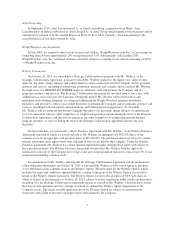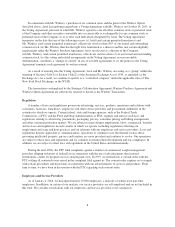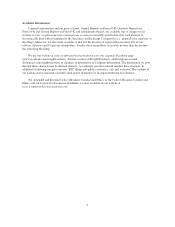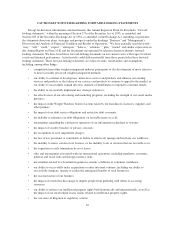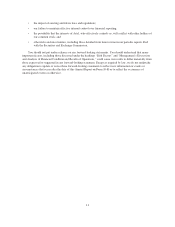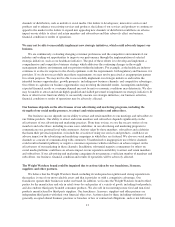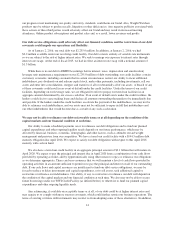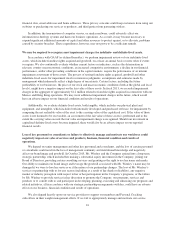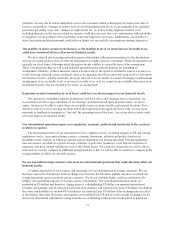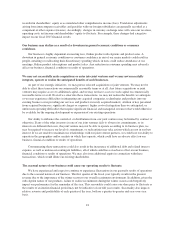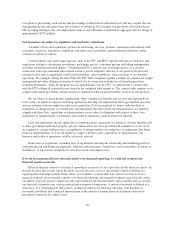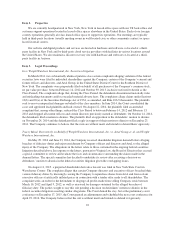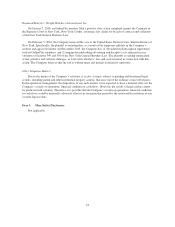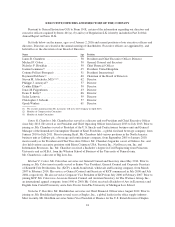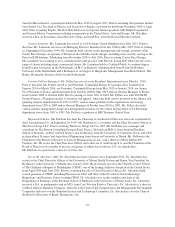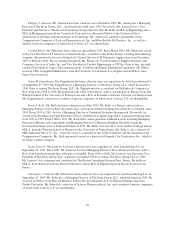WeightWatchers 2015 Annual Report Download - page 20
Download and view the complete annual report
Please find page 20 of the 2015 WeightWatchers annual report below. You can navigate through the pages in the report by either clicking on the pages listed below, or by using the keyword search tool below to find specific information within the annual report.providers, we may not be able to adequately service our customers which could negatively impact our sales of
services and products. Changes in factors such as overall unemployment levels, local competition for qualified
personnel, prevailing wage rates, changes in employment law, as well as rising employee benefits costs,
including insurance in the areas in which we operate, could increase our labor costs and interfere with our ability
to adequately retain qualified service providers to provide support to customers. Additionally, our inability to
attract and retain qualified personnel could delay or hinder our successfully executing our strategic initiatives.
The inability to renew certain of our licenses, or the inability to do so on terms that are favorable to us,
could have a material adverse effect on our financial results.
We have entered into licensing and endorsement relationships with numerous partners for the distribution
and sale of certain products that are relevant and helpful to weight-conscious consumers. These arrangements are
typically for fixed terms, following which the parties decide whether to extend the term of the arrangement.
There is no guarantee that we will reach mutually agreeable terms with our partners for extending an
arrangement. Similarly, in those instances where a licensee enjoys the option to extend the term of a license as a
result of having achieved certain conditions, there is no guarantee that the licensee will avail itself of such option.
Our financial results could be materially adversely affected if we are unable to extend a licensing or endorsement
arrangement, if we are unable to do so on terms favorable to us, or if we cannot locate a suitable alternative to an
incumbent licensee who has decided not to renew its arrangement.
Expiration or early termination by us of leases could have an adverse impact on our financial results.
Our operations, including corporate headquarters and back-office and customer service operations, are
located in leased office space and many of our meetings are held in leased space in retail centers. As leases
expire, we may not be able to renew them on acceptable terms or secure suitable replacement locations. If we
decide to relocate or close meeting locations before the expiration of the applicable lease term, we may incur
payments to landlords to terminate or “buy out” the remaining term of the lease. Any of the above events could
adversely impact our financial results.
Our international operations expose us to regulatory, economic, political and social risks in the countries
in which we operate.
The international nature of our operations involves a number of risks, including changes in US and foreign
regulations, tariffs, taxes and exchange controls, economic downturns, inflation and political and social
instability in the countries in which we operate and our dependence on foreign personnel. Foreign regulations
may also restrict our ability to operate in some countries, acquire new businesses, recur bill our customers or
repatriate cash from foreign subsidiaries back to the United States. We cannot be certain that we will be able to
enter and successfully compete in additional foreign markets or that we will be able to continue to compete in the
foreign markets in which we currently operate.
We are exposed to foreign currency risks from our international operations that could adversely affect our
financial results.
A significant portion of our revenues and operating costs are denominated in foreign currencies. We are
therefore exposed to fluctuations in the exchange rates between the US dollar and the currencies in which our
foreign operations receive revenues and pay expenses. We do not currently hedge, and have not historically
hedged, our operational exposure to foreign currency fluctuations. Our consolidated financial results are
presented in US dollars and therefore, during times of a strengthening US dollar, our reported international
revenues and earnings will be reduced because the local currency will translate into fewer US dollars. In addition,
the assets and liabilities of our non-US subsidiaries are translated into US dollars at the exchange rates in effect
at the balance sheet date. Revenues and expenses are translated into US dollars at the average exchange rate for
the period. Translation adjustments arising from the use of differing exchange rates from period to period are
17


